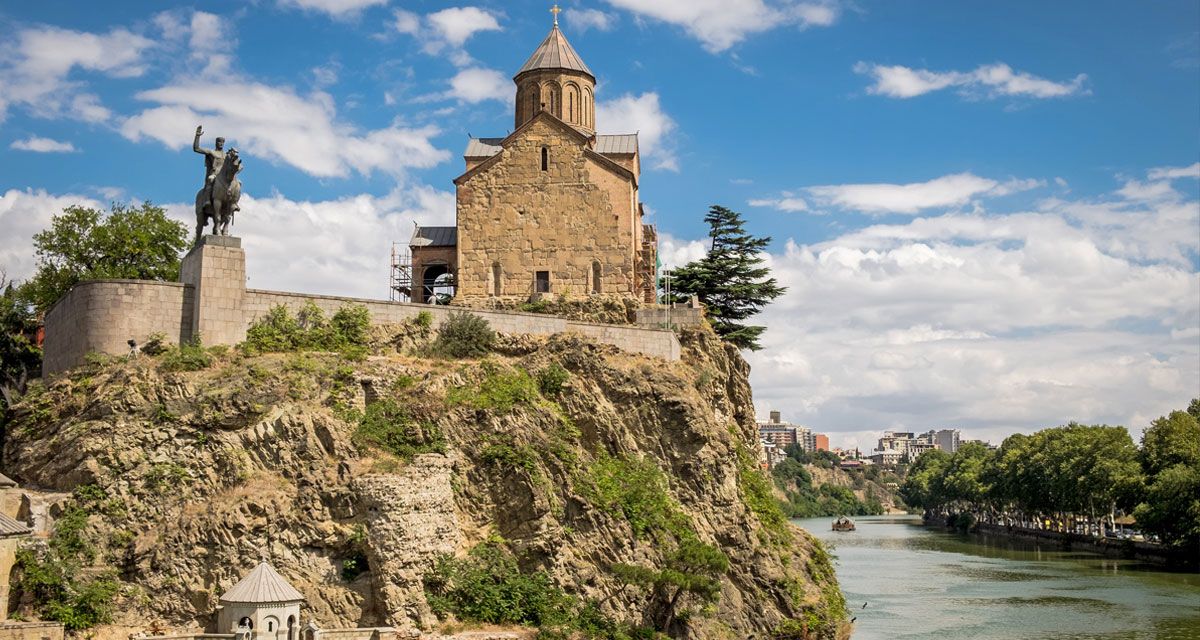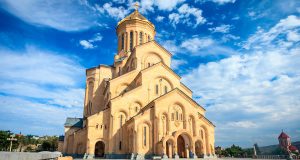5 churches in Tbilisi which is worth seeing at least once

Christianity has been declared the state religion of Georgia since the 4th century. Today the Church of Georgia is an undivided part of the World Orthodox Church.
Most of the population of Georgia is Christian. Christianity has become an important part of Georgian culture and history over the centuries.
There are many churches in Tbilisi of great historical and cultural importance.
Do you know which 5 beautiful churches you should definitely visit in Tbilisi?
There list of 5 most known churches of Tbilisi – you should visit, despite the fact that there a lot of beautiful churches in Tbilisi to visit.
The Holy Trinity Cathedral of Tbilisi
The Holy Trinity Cathedral is the largest Orthodox cathedral in Georgia. The Tsminda Sameba Temple, built on Mount Ilinskaya, is one of the largest in size in the Caucasus.
The temple is a symbol of Christianity for the country and the most popular tourist destination in Tbilisi. It is a monument built in the style of cruciform architecture, a mixture of old and modern architecture.
The construction of the church began in 1989 and ended in 2004 with the blessing of the Catholicos-Patriarch of All Georgia. The construction of the project is associated with the name of Archil Mindiashvili, who created the temple on the basis of completely new, ancient traditions and modern elements.
The architecture of the cathedral is combined with the urban style, which also combines modern and old buildings.
The Trinity Cathedral covers two main areas: the aboveground and underground areas. In Sameba Cathedral, the entrance is accessible from 3 main sides: from the south, from the west, and from the east.
Almost all the elevated central parts of Tbilisi open a view of the Trinity Cathedral, which surprises any person with its beauty, grandeur, and architecture. The Holy Trinity Cathedral of Tbilisi The Holy Trinity Cathedral is the largest Orthodox cathedral in Georgia. The Tsminda Sameba Temple, built on Mount Ilinskaya, is one of the largest in size
in the Caucasus.
The temple is a symbol of Christianity for the country and the most popular tourist destination in Tbilisi. It is a monument built in the style of cruciform architecture, a mixture of old and modern architecture.
The construction of the church began in 1989 and ended in 2004 with the blessing of the Catholicos-Patriarch of All Georgia. The construction of the project is associated with the name of Archil Mindiashvili, who created the
temple on the basis of completely new, ancient traditions and modern elements.

The architecture of the cathedral is combined with the urban style, which also combines modern and old buildings.
The Trinity Cathedral covers two main areas: the aboveground and underground areas. In Sameba Cathedral, the entrance is accessible from 3 main sides: from the south, from the west, and from the east.
„Lorem ipsum dolor sit amet, consectetur adipisicing elit, sed do eiusmod tempor incididunt ut labore et dolore magna aliqua.“
Almost all the elevated central parts of Tbilisi open a view of the Trinity Cathedral, which surprises any person with its beauty, grandeur, and architecture.
Metekhi Church of the Nativity of the Virgin Mary
Metekhi Church of the Nativity of the Virgin Mary is a monument of great historical importance. The cathedral is raised on a rocky hill in the old part of Tbilisi, on Metekhi street.
Metekhi Cathedral was built with ancient Georgian and classical architecture, as indicated by the location of the walls. In the 6th century, King Vakhtang Gorgasali built a fortress, a church, and a palace on the Metekhi hill.
However, as it is known from historical sources, the monastery was built by King Demeter II and the present appearance of the temple is associated with his name.
Over time, the architectural aspect of the temple has changed; it has become a historically important and famous tourist destination.
The remains of Saint Shushanik were buried in the Metekhi Cathedral, which is one of the great shrines of the temple. The temple's strategic location and architecture constantly attract the attention of visitors.
The Sioni Cathedral of the Dormition
The Sioni Cathedral is a patriarchal, cathedral and historical cathedral in the central part of Tbilisi. Sioni Temple is located on the right bank of the Mtkvari River, on Sioni Street.
The construction of the temple began in the 6th century when Kartli was ruled by Guram Kurapalati. In the years 570-580 eristavi Kartli Guram Kurapalati laid the foundation for the new temple of Sioni. The construction of the Sioni
Cathedral lasted about 100 years and was completed in the second half of the 7th century. The Sioni Cathedral has a central domed view with medieval architecture.
The temples of Sioni were repeatedly destroyed by the enemies of Georgia, which several times led to the restoration of the temple and the change in architecture. One of the important historical facts is connected with Shah Khvarazmi, Jalal-e-Din, who took Tbilisi in the 13th century. By his order, in the Sioni Cathedral, the dome was removed and was put a throne in its place.
By order of Jalal-ed-Din, he doomed to martyrdom one hundred thousand of Georgians, who chose to worship the holy icons of the temple and protect their religion.
Hundreds of tourists visit the Temple of Sioni today.
Narikala – Cathedral of St. Nicholas
Church of St. Nicholas – Narikala was built on one of the oldest castles in Georgia, Narikala. The temple was built in the XII century during the reign of King Demeter the Great.
In the 19th century, when Georgia joined Russia, the Narikala temple became a storehouse for gunpowder. Later, the church was completely destroyed by a powerful explosion.
In 1996, a new St. Nicholas Church was built on the old foundation. The surviving remains of the 13th century are still preserved in new construction.
From the Narikala fortress, where the temple was built, the view of Tbilisi is full of historical and cultural monuments. The Trinity Cathedral is also visible from here.
Narikala can be reached by cable car from Rike Park.
Church of St. David Mamadaviti on the Mtatsminda Pantheon
Mtatsminda Mamadaviti Church is located on Mtatsminda Street in Tbilisi. The cathedral is an example of a Georgian domed built of bricks.
The construction of the temple is associated with the name of Father David Garejeli, which begins in the 6th century. Father David Garejeli was one of the Assyrian fathers, who during his stay in Tbilisi, carved a small cell and built a prayer room.
In honor of David’s father, the Georgians named Mount Mamadavit.
In fact, the construction of a new and larger temple began in 1857 and ended in 1871. From the Mamadaviti Church there is a path to Mount Mtatsminda, along which one can climb to the Mtatsminda Park.